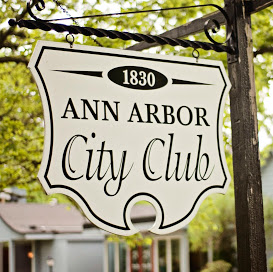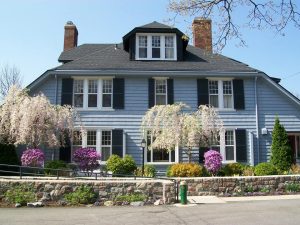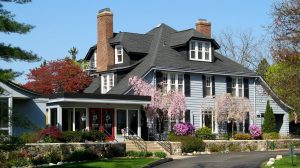The Three Lives of 1830 Washtenaw
Author: Grace Shackman
The stately and prestigious Women’s City Club started as a simple farmhouse.
In its 100-plus years, 1830 Washtenaw has changed in harmony with the street it faces. Built when Washtenaw was a dirt country road, it was first a simple, boxy farmhouse. When Washtenaw became a fashionable address, the house was ingeniously transformed into an imposing home for a wealthy physician. As the Women’s City Club since 1951, it has continued to evolve, expanding physically and adapting socially as it moves to encompass the needs of career women as well as club women. It provides meeting space for seventeen member clubs and 900 individual members, to whom its dining room, lounges, and library are an ideal place to hang out, entertain guests, or, in the case of the increasing number of professional women members, meet with clients.
 The house was built by Evart Scott, who moved to Ann Arbor from Ohio in 1868 to attend the U-M. Scott completed only two years of college, but stayed in town to become a successful businessman, civic activist, and farmer. He was president of the Ann Arbor Agricultural Co., which ran a mill at Argo dam, and a member of the school board, the public works board, and the board of Forest Hills Cemetery.
The house was built by Evart Scott, who moved to Ann Arbor from Ohio in 1868 to attend the U-M. Scott completed only two years of college, but stayed in town to become a successful businessman, civic activist, and farmer. He was president of the Ann Arbor Agricultural Co., which ran a mill at Argo dam, and a member of the school board, the public works board, and the board of Forest Hills Cemetery.
Scott moved into the house on Washtenaw in 1886, a few years after starting an orchard and nursery on what was then a thirty-acre plot just outside the city limits. He planted elm trees along his 1,000-foot Washtenaw frontage (from present-day Ferdon all the way to Austin) and named it “Elm Fruit Farm.”
In 1915, after the city had annexed the area, Scott sold the bulk of his farmland to Charles Spooner. Spooner subdivided it into building lots and, in collaboration with architect Fiske Kimball, built the elegant homes that still grace the neighborhood. Reminders of the land’s earlier owner can be found in the street names Scottwood and Austin (the name of Scott’s father, brother, and son) and in a few ancient fruit trees, most of them pear, found in the neighborhood.
Two years after selling the land, Scott moved to a smaller house at 1930 Washtenaw, on the eastern edge of his property. He sold the big house and three acres of land to Dr. R. Bishop Canfield, a professor in the medical school who was returning to town after wartime duty in the U.S. Medical Corps.
Canfield hired architect Lewis J. Boynton to turn the forty-year-old farmhouse into something more suitable for its increasingly prestigious address. Boynton succeeded in  transforming the simple box into an impressive house in the then fashionable Dutch colonial revival style. He replaced the old-fashioned wraparound porch with small extensions on each end of the house. Then he added a massive sloping roof that came down over the porches and allowed the attic windows to peek through as dormers. The finishing touch was a delicate front entrance porch with slender Ionic columns.
transforming the simple box into an impressive house in the then fashionable Dutch colonial revival style. He replaced the old-fashioned wraparound porch with small extensions on each end of the house. Then he added a massive sloping roof that came down over the porches and allowed the attic windows to peek through as dormers. The finishing touch was a delicate front entrance porch with slender Ionic columns.
Canfield was one of the nation’s leading specialists in ear, nose, and throat problems. He and his wife, Leila, a nurse from Colorado, had one child, a redheaded adopted daughter, Barbara. Alva Sink, a longtime member of the Women’s City Club, knew the Canfield family well. For three of the years that she was a student at the U-M in the early 1920’s, she ran a private school on their third floor, teaching Barbara and five other children of prominent families, including Jane Burton, daughter of the U-M president. Mrs. Sink remembers the Canfield house as “beautiful,” and says that the interior “looked much as it does today.” She recalls that Mrs. Canfield’s help included a cook, maid, and yardman.
Canfield died in 1932, at age fifty-eight, when his car ran into a tree near the present site of Arborland. He was returning home after driving his wife and daughter and Dr. and Mrs. A. C. Furstenberg (he would later become dean of the medical school) to Detroit to catch a train to New York, where all but Mrs. Canfield were to sail for Europe. Mrs. Canfield hurried home as soon as she received news of her husband’s death. Unfortunately, the Furstenbergs and Barbara had already sailed. Informed by ship’s radio, they could do nothing but sail on to Gilbraltar, where they boarded a ship returning to the U.S.
Mrs. Canfield continued to live in the house until her death almost twenty years later. When the house went on the market in 1950, a group of local women were looking for a location for a women’s club. Up to then, many groups had met on campus, especially in the Women’s League, but increased enrollment at the U-M after World War II made university space harder to obtain.
By then, too, Washtenaw’s big houses weren’t quite so desirable as they’d been: few postwar families could afford servants to care for rambling buildings and grounds, and the street’s increasingly heavy traffic was a worry for children. (Washtenaw at that time was part of Route 23, which went through town.) To the chagrin of residents, some houses were being taken over by fraternities, sororities, and other institutional users like the First Unitarian Church, which had recently bought and remodeled a former home down the block.
There was opposition to the conversion of the Canfield home, but the proponents were capable, well-connected, and hardworking women. When critics said the house was not strong enough to hold the weight of large gatherings, member Elsie White had her husband, Dr. Albert White, head of engineering research at the U-M, arranged to have the house checked. Free financial advice was given by Earl Cress of Ann Arbor Trust, while the Roscoe Bonisteels, Sr. and Jr., donated legal advice.
The key hurdle of changing the residential zoning was solved after the group negotiated an agreement with the six nearest neighbors that they would tell the city council they had no objections to the club as long as there were no exits from the rear onto Norway.
After Barbara Canfield, by then married  and living in Chicago, accepted the City Club’s offer of $45,000 in January of 1951, the group went to work raising money. Margaret Towsley, secretary of the founding group, sent letters to all the women’s clubs in town asking them to join and also to encourage at least a quarter of their group to enroll as individual members. Twenty-one clubs and 600 individual members responded, and by June 20, 1951, the final papers were signed. Supplementing membership fees with fund-raising activities, the group managed to pay the entire mortgage within five years. Just six years later, architect Ralph Hammett was hired to design a modern addition to house a large dining room, auditorium, office, main lobby, and lounge.
and living in Chicago, accepted the City Club’s offer of $45,000 in January of 1951, the group went to work raising money. Margaret Towsley, secretary of the founding group, sent letters to all the women’s clubs in town asking them to join and also to encourage at least a quarter of their group to enroll as individual members. Twenty-one clubs and 600 individual members responded, and by June 20, 1951, the final papers were signed. Supplementing membership fees with fund-raising activities, the group managed to pay the entire mortgage within five years. Just six years later, architect Ralph Hammett was hired to design a modern addition to house a large dining room, auditorium, office, main lobby, and lounge.
Today, women’s clubs in many cities have lost members or completely ceased to exist due to the large number of women working outside the home. So far, the Ann Arbor club has maintained itself well. Though membership has fallen by about 200 women from its peak in 1970, the club is actively recruiting younger members with more evening programs, more events open to men, and a deferred membership payment plan for daughters of members. (The membership initiation fee is $200 and annual dues are $175.) Some of the younger members are housewives deferring careers to raise children, but many are career women – real estate agents, lawyers, and accountants. Says club archivist Ruth Whitaker, “It provides a forum for women doing volunteer work to touch base with people in the work world.” Club president Greta Smith adds, “It’s a good way to meet people if you’re new in the area.”
Most importantly, enthusiasm is still high. Elsie White describes the club as “a great blessing to the community,” while Sink says, “It’s the best thing Ann Arbor ever did for women – or rather, that they did for themselves.”
